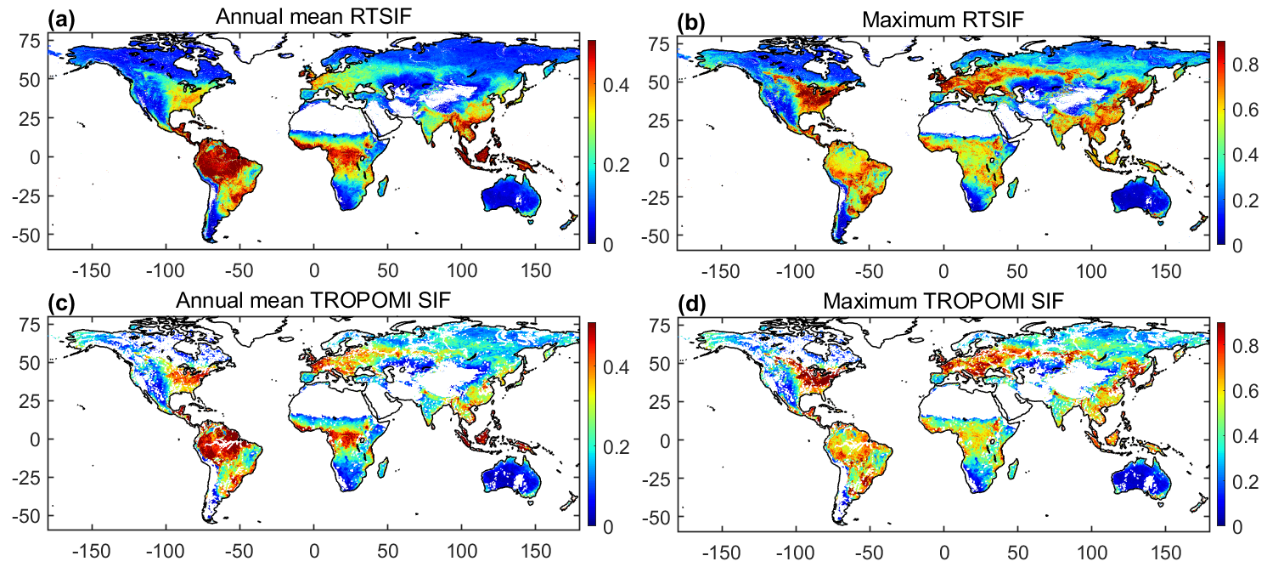新闻动态
NEWS

Global high-resolution solar-induced fluorescence dataset Published
Recently, the research team from Tsinghua University and Qinghai University led by Professor HUANG Yuefei published an article entitled "A long-term reconstructed TROPOMI solar-induced fluorescence dataset using machine learning algorithms" in Scientific Data (IF: 8.501). Its associated data "Global High Resolution (8 days, 0.05°) Daylight Induced Chlorophyll Fluorescence Dataset (2001-2020)" has been published and shared at the National Tibetan Plateau/Third Pole Environment Data Center (http://data.tpdc.ac.cn).
Photosynthesis is a key process linking carbon and water cycles, and satellite-retrieved solar-induced chlorophyll fluorescence (SIF) can be a valuable proxy for photosynthesis and is widely used for total primary productivity (GPP) estimation. Existing SIF data have long been limited by low spatial resolution and sparse data sampling. The TROPOspheric Monitoring Instrument (TROPOMI) on the Copernicus Sentinel-5P mission enables significant improvements in providing high spatial and temporal resolution SIF observations, but the short temporal coverage of the data records has limited its applications in long-term studies. As research on the application of SIF in ecology and related fields continues, there is an urgent need to generate global high-resolution spatio-temporally continuous long time series SIF products. This dataset provides global high-resolution solar-induced chlorophyll fluorescence data of long time series from 2001 to 2020, which effectively alleviates the above problems.
The dataset was produced based on the XGBoost machine learning model with the main inputs of the MODIS surface reflectance data, surface temperature and land type products, CERES reanalysis data, and C3/C4 vegetation cover data to reconstruct the TROPOMI SIF (RTSIF) for the period 2001-2020 under clear sky conditions. The dataset was validated against the TROPOMI SIF and the tower-based SIF, and compared with other satellite-derived SIFs (GOME-2 SIF and OCO-2 SIF) to demonstrate the accuracy of the data. This dataset will be valuable in assessing long-term terrestrial photosynthesis and constraining the global carbon budget and associated water fluxes.

Figure. Spatial pattern of average and maximum (90th percentile) daily values for RTSIF (a and b) and TROPOMI SIF (c and d) in 2019. All the values are in units of mWm−2nm−1sr−1.
This study is financially supported by the National Natural Science Foundation of China (No. 91847301and No.51809007), the Central Funds Guiding the Local Science and Technology Development of Qinghai Province (2021ZY024), Major Basic Research Development Program of the Science and Technology Agent, Qinghai Province (2019-SF-146) and the State Key Laboratory of Hydroscience and Engineering-Tsinghua (No. 2019-KY-01).
Article:
Chen, X., Huang, Y., Nie, C., Zhang, S., Wang, G., Chen, S., Chen, Z. (2022). A long-term reconstructed TROPOMI solar-induced fluorescence dataset using machine learning algorithms. Scientific Data 9.
Article available at:
https://www.nature.com/articles/s41597-022-01520-1
Data available at:
https://data.tpdc.ac.cn/en/data/2b8ffbf4-90ac-4e3d-9ae4-a8be31ae93d4/



 京公网安备11010502040845号
京公网安备11010502040845号